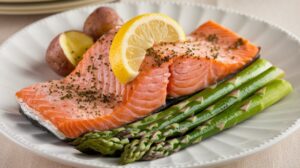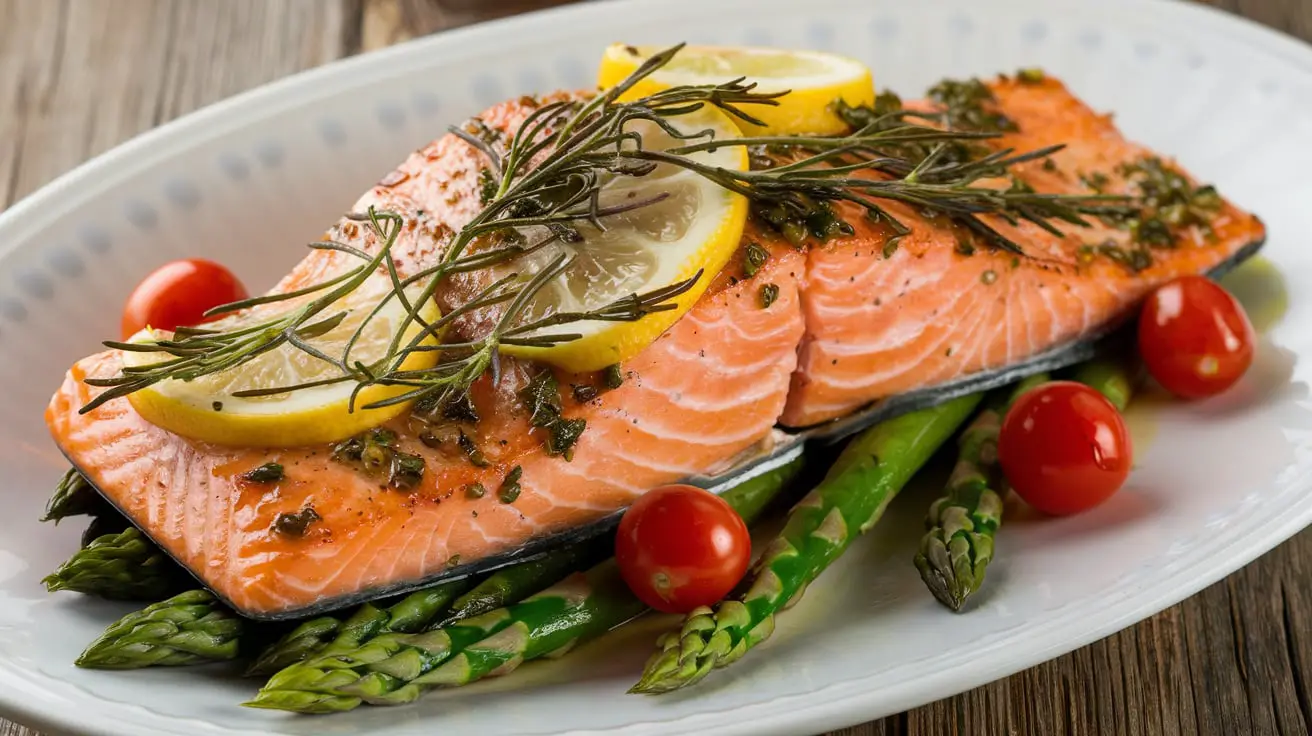The Ultimate Guide to Baked Salmon: Everything You Need to Know
Baked salmon is a delicious and healthy option that can be enjoyed on its own or as part of a larger meal. It’s packed with nutrients like omega-3 fatty acids, protein, and vitamins, making it a perfect choice for anyone seeking a nutritious dinner option. With the right approach, you can bake salmon to perfection every time, ensuring a juicy and flavorful dish.
In this ultimate guide, we’ll walk you through everything you need to know about baking salmon, from choosing the right fillet to preparing it and pairing it with complementary sides. By the end of this guide, you’ll be able to confidently prepare your own baked salmon and explore various ways to enhance its flavor. Whether you’re a beginner or a seasoned cook, this comprehensive guide will help you become an expert at baking salmon.
For those new to cooking salmon, you may find it helpful to check out this resource: How to cook frozen salmon. It offers excellent tips for beginners and seasoned cooks alike, ensuring you can confidently bake even frozen fillets.
Additionally, salmon is a versatile protein, meaning it can be baked in a variety of ways. You can easily make this dish your own by experimenting with flavors and seasonings. For inspiration, consider browsing through this list of 15 delicious and easy salmon recipes, which will provide you with creative ideas for making your salmon even more flavorful.
Table of Contents
- Why Choose Baked Salmon?
- Nutritional Benefits of Baked Salmon
- Choosing the Right Salmon for Baking
- Preparing Your Salmon
- Baking Salmon: Step-by-Step Guide
- Flavor Enhancements and Variations
- Side Dishes to Pair with Baked Salmon
- Wine and Beverage Pairings
- Storing and Reheating Leftover Baked Salmon
- FAQs About Baked Salmon
- Conclusion
Why Choose Baked Salmon?

Salmon is an ideal protein choice for many reasons. Its rich, tender texture and mild flavor make it a versatile ingredient for many different recipes. The health benefits are another compelling reason to incorporate more salmon into your diet. Unlike other meats, salmon is known for its heart-healthy omega-3 fatty acids, which have been shown to reduce inflammation, improve cardiovascular health, and support brain function.
Baking salmon ensures it retains its moisture and flavors, making it one of the best cooking methods for the fish. Whether you’re trying to maintain a healthy lifestyle or simply want a quick, easy dinner, baked salmon is a perfect option.
Additionally, you don’t need to worry about overcooking the fish because baking provides consistent, even heat, allowing for a juicy, flaky result. If you’re looking for more salmon tips, including how to cook it from frozen, check out this informative resource on cooking frozen salmon and discover how to prepare this delicious fish no matter your skill level.
Nutritional Benefits of Baked Salmon
Baked salmon is more than just tasty – it’s packed with nutritional benefits that make it a top choice for a balanced diet. Here’s why you should consider adding salmon to your regular meal plan:
- Omega-3 fatty acids: These healthy fats are essential for heart health, reducing inflammation, and improving cognitive function.
- High-quality protein: Salmon is a great source of complete protein, providing all the essential amino acids your body needs to repair tissues and build muscle.
- Vitamins: It’s rich in vitamin B12, which supports brain function and energy production, as well as vitamin D, which helps maintain healthy bones and teeth.
- Minerals: Salmon contains high levels of selenium, an important antioxidant that supports immune function, and potassium, which helps regulate blood pressure.
Incorporating salmon into your diet is an excellent way to get a variety of essential nutrients while enjoying a flavorful and easy-to-prepare meal.
Choosing the Right Salmon for Baking
To achieve the best results with your baked salmon, it’s important to choose the right type of fish. Here are some tips for selecting the perfect fillet:
- Types of Salmon: There are several types of salmon, each with a slightly different flavor profile. Sockeye has a rich, deep flavor and firm texture, while Coho offers a milder taste. Atlantic salmon is often farmed and tends to have a milder flavor, making it a popular choice for those who prefer a subtler taste.
- Fresh vs. Frozen: Both fresh and frozen salmon can be baked, but fresh salmon is typically more flavorful. If you’re using frozen salmon, it’s important to thaw it properly to prevent it from becoming too dry. Learn more about the best ways to thaw and cook frozen salmon by checking out this guide on cooking frozen salmon.
- Sustainability: Look for sustainably sourced salmon to support ethical fishing practices. Choose wild-caught salmon over farmed salmon when possible, as it tends to be more flavorful and nutrient-dense.
When you select the right salmon, you’ll be setting yourself up for a successful and delicious baked meal.
Preparing Your Salmon
Once you’ve chosen your salmon, the next step is preparing it. Proper preparation ensures your salmon cooks evenly and absorbs the seasonings for maximum flavor. Here’s how to prepare your salmon:
- Thawing: If you’re using frozen salmon, it’s important to thaw it before baking. The best method is to place the salmon in the refrigerator overnight, but you can also use the cold water method for quicker thawing. To do this, place the salmon in a sealed plastic bag and submerge it in cold water for about an hour.
- Removing Bones: Even the most careful fishmongers may leave small pin bones in the fillet. Use a pair of fish tweezers or regular tweezers to gently pull out any bones you find.
- Skinning: While you can leave the skin on when baking salmon, some people prefer to remove it for a cleaner presentation. If you want to remove the skin, simply run a sharp knife along the edges of the fillet, between the skin and the flesh.
- Seasoning: Season your salmon with salt, pepper, and your choice of herbs. Lemon, garlic, dill, and thyme are classic seasonings, but feel free to get creative with your spices.
Proper preparation is essential to ensure that your baked salmon has the right texture and flavor.
Baking Salmon: Step-by-Step Guide
Now that your salmon is prepared, it’s time to bake it. Follow these steps to bake your salmon to perfection:
- Preheat your oven to 375°F (190°C). This temperature ensures your salmon cooks evenly while retaining moisture.
- Prepare your baking sheet by lining it with parchment paper or aluminum foil. This makes cleanup easier and prevents the salmon from sticking.
- Place the salmon on the baking sheet with the skin-side down if it still has skin. This helps the skin crisp up and prevents the flesh from drying out.
- Season generously with salt, pepper, and your favorite herbs.
- Bake for 12-15 minutes, depending on the thickness of your fillet. Salmon is cooked when it easily flakes with a fork and reaches an internal temperature of 145°F (63°C).
For an extra crispy finish, consider broiling the salmon for the last 2-3 minutes of baking.
Flavor Enhancements and Variations
Baked salmon is a blank canvas for various flavor enhancements. Here are some ways to elevate your dish:
- Herbs and spices: Experiment with different herbs like rosemary, parsley, or basil, or add a touch of paprika for a smoky flavor.
- Citrus: Add a drizzle of lemon or lime juice before baking for a fresh, zesty finish.
- Glazes and marinades: Consider using a honey mustard glaze, or marinate your salmon in soy sauce, garlic, and ginger for an Asian-inspired twist.
These flavor variations allow you to customize your baked salmon to suit your preferences.
Side Dishes to Pair with Baked Salmon
To complete your meal, serve your baked salmon with complementary sides. Here are some ideas:
- Vegetables: Roasted asparagus, brussels sprouts, or a green bean almondine are great choices to pair with the richness of salmon.
- Grains: Serve your salmon with quinoa, brown rice, or couscous for a hearty and nutritious side.
- Salads: A fresh spinach salad or cucumber and tomato salad with balsamic dressing will provide a light and refreshing contrast to the richness of the salmon.
Pairing salmon with the right sides will enhance the overall flavor of your meal.
Wine and Beverage Pairings
Choosing the right drink to accompany your baked salmon can elevate the meal even further. Here are some suggestions:
- White wines: A crisp, dry white wine such as Chardonnay or Sauvignon Blanc pairs beautifully with the delicate flavor of salmon.
- Non-alcoholic options: Sparkling water with a wedge of lemon or a chilled herbal iced tea will complement the freshness of the salmon.
Storing and Reheating Leftover Baked Salmon
If you have leftover baked salmon, follow these tips to store and reheat it:
- Storage: Store leftover salmon in an airtight container in the refrigerator for up to 2 days.
- Reheating: To preserve moisture, reheat salmon in a low-temperature oven (around 300°F or 150°C). Cover with foil to prevent it from drying out.
FAQs About Baked Salmon
Here are answers to some frequently asked questions:
- How do I prevent my baked salmon from drying out?
- Bake at a moderate temperature and consider covering the fish with foil for the first few minutes to retain moisture.
- Can I bake salmon without the skin?
- Yes, you can bake salmon skinless, though the skin helps retain moisture during cooking.
- How do I know when my salmon is done?
- Salmon is done when it flakes easily with a fork and has an internal temperature of 145°F (63°C).
- Can I use frozen salmon for baking?
- Yes, frozen salmon can be baked. Just be sure to thaw it properly for the best results.
Conclusion
Baked salmon is a healthy, easy-to-prepare, and flavorful dish that can be enjoyed in many different ways. Whether you are looking for a simple weeknight dinner or a dish to impress at a dinner party, baked salmon is a versatile and reliable choice. By following the steps outlined in this guide, you’ll be able to bake perfect salmon every time, and you’ll have the confidence to explore different flavor combinations and sides.

